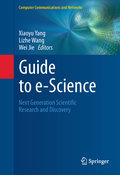
Guide to e-Science: next generation scientific research and discovery
Yang, Xiaoyu
Wang, Lizhe
Jie, Wei
This guidebook on e-science presents real-world examples of practices and applications, demonstrating how a range of computational technologies and tools can be employed to build essential infrastructures supporting next-generation scientific research. Each chapter provides introductory material on core concepts and principles, as well as descriptions and discussions of relevant e-science methodologies, architectures, tools, systems, services and frameworks. Features: includes contributions from an international selection of preeminent e-science experts and practitioners; discusses use of mainstream grid computing and peer-to-peer grid technology for “open” research and resource sharing in scientific research; presents varied methods for data management in data-intensive research; investigates issues of e-infrastructure interoperability, security, trust and privacy for collaborative research; examines workflow technology for the automation of scientific processes; describes applications of e-science. Includes contributions from an international selection of preeminent e-science experts and practitioners. Examines how e-science techniques can be used to facilitate “open” research and resource sharing, data-intensive research, collaborative research, and scientific workflows. Describes applications of e-science, highlighting systems used in the fields of biometrics, clinical medicine, and ecology. INDICE: Part I: Sharing and Open Research. Implementing a Grid. Cloud e-Science Infrastructure for Hydrological Sciences. The German Grid Initiative. Democratizing Resource-Intensive e-Science Through Peer-to-Peer Grid Computing. Peer4Peer: E-science Communities for Overlay Network and Grid Computing Research. Part II: Data-Intensive e-Science. A Multi-Disciplinary, Model-Driven, Distributed Science Data System Architecture. An Integrated Ontology Management and Data Sharing Framework for Large-Scale Cyberinfrastructure. Part III: Collaborative Research. An e-Science Cyberinfrastructure for Solar-enabled Water Production and Recycling. e-Science Infrastructure Interoperability Guide. Trustworthy Distributed Systems Through Integrity-Reporting. An Intrusion DiagnosisPerspective on Cloud Computing. Part IV: Research Automation, Reusability, Reproducibility and Repeatability. Conventional Workflow Technology for Scientific Simulation. Facilitating E-Science Discovery Using Scientific Workflows on the Grid. Concepts and Algorithms of Mapping Grid-Based Workflows to ResourcesWithin an SLA Context. Orchestrating e-Science with the Workflow Paradigm. Part V: e-Science: Easy Science. Face Recognition using Global and Local SalientFeatures. OGSA-Based SOA for Collaborative Cancer Research. e-Science.
- ISBN: 978-0-85729-438-8
- Editorial: Springer London
- Encuadernacion: Cartoné
- Páginas: 558
- Fecha Publicación: 01/03/2011
- Nº Volúmenes: 1
- Idioma: Inglés
